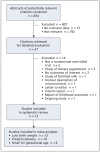Effects of prenatal multimicronutrient supplementation on pregnancy outcomes: a meta-analysis
- PMID: 19506270
- PMCID: PMC2691425
- DOI: 10.1503/cmaj.081777
Effects of prenatal multimicronutrient supplementation on pregnancy outcomes: a meta-analysis
Abstract
Background: Reduced intake of micronutrients during pregnancy exposes women to nutritional deficiencies and may affect fetal growth. We conducted a systematic review to examine the efficacy of prenatal supplementation with multimicronutrients on pregnancy outcomes.
Methods: We searched MEDLINE, EMBASE, CINAHL and the Cochrane Library for relevant articles published in English up to December 2008. We also searched the bibliographies of selected articles as well as clinical trial registries. The primary outcome was low birth weight; secondary outcomes were preterm birth, small-for-gestational-age infants, birth weight and gestational age.
Results: We observed a significant reduction in the risk of low birth weight among infants born to women who received multimicronutrients during pregnancy compared with placebo (relative risk [RR] 0.81, 95% confidence interval [CI] 0.73-0.91) or iron-folic acid supplementation (RR 0.83, 95% CI 0.74-0.93). Birth weight was significantly higher among infants whose mothers were in the multimicronutrient group than among those whose mothers received iron-folic acid supplementation (weighted mean difference 54 g, 95% CI 36 g-72 g). There was no significant differences in the risk of preterm birth or small-for-gestational-age infants between the 3 study groups.
Interpretation: Prenatal multimicronutrient supplementation was associated with a significantly reduced risk of low birth weight and with improved birth weight when compared with iron-folic acid supplementation. There was no significant effect of multimicronutrient supplementation on the risk of preterm birth or small-for-gestational-age infants.
Figures






Comment in
-
Prenatal micronutrient supplementation: are we there yet?CMAJ. 2009 Jun 9;180(12):1188-9. doi: 10.1503/cmaj.090652. CMAJ. 2009. PMID: 19506273 Free PMC article. No abstract available.
References
-
- Smith CA. Effects of maternal undernutrition upon the newborn infant in Holland (1944–45) J Pediatr. 1947;30:229–43. - PubMed
-
- Gopalan C. Multiple micronutrient supplementation in pregnancy. Nutr Rev. 2002;60:S2–6. - PubMed
-
- Keen CL, Clegg MS, Hanna LA, et al. The plausibility of micronutrient deficiencies being a significant contributing factor to the occurrence of pregnancy complications. J Nutr. 2003;133(Suppl 2):1597S–605S. - PubMed
-
- Susser M. Maternal weight gain, infant birth weight, and diet: causal sequences. Am J Clin Nutr. 1991;53:1384–96. - PubMed
-
- Fawzi WW, Msamanga GI, Urassa W, et al. Vitamins and perinatal outcomes among HIV-negative women in Tanzania. N Engl J Med. 2007;356:1423–31. - PubMed
Publication types
MeSH terms
Substances
LinkOut - more resources
Full Text Sources
Medical
